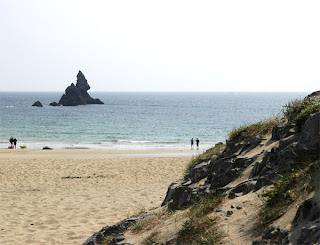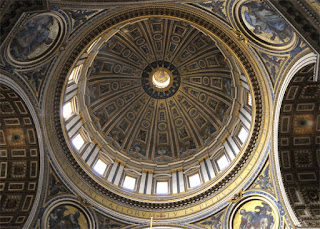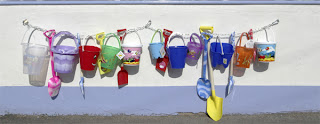Project: The Intensity of Light
Exercise: Measuring exposure
Part 1: For this exercise I produced four photographs that are deliberately lighter or darker than average. The images are shown below:
 |
| 5156.jpg; Pentax *istD; 18-55mm lens; F/22; 1/250s |
This photograph was produced deliberately lighter than average to portray the feeling that is felt when on the beach on a bright sunny day.
 |
| 5728.jpg; Pentax *istD; 18-55mm lens; F/22; 1/125s |
This photograph has been produced deliberately lighter than average to make the most of the colours of the boats on the water and the green and blue of the background. This gives a bright, cheerful mood to the image.
 |
| Nikon D300; 18-70mm lens; F/9; 1/13s |
This photograph was produced darker than average to add a sombre,
ecclesiastic mood to the image. The inside of the church was kept deliberately dark to contrast with the brightness of the light from the windows in the dome.
 |
| Pentax *istD; 18-55mm lens; F/22; 4s |
This image was produced darker to create a more romantic mood and to contrast the brightness of the candles against the background.
Part 2: For this part of the exercise I took five different photographs. For each one I made five exposures, arranged around the one recommended by the camera's computer as the best exposure. The first one was one stop darker, the second half a stop, the third average, the fourth half a stop lighter and the fifth one stop lighter.
Once the photographs had been processed, I looked at them to see whether the central exposure was what I wanted. Next I looked to see if any of the other exposures were acceptable.
The images that were acceptable are shown below:
 |
| 5104.jpg; Pentax *istD; 18-55mm lens; F/11; 1/1000s |
This photograph was taken using the camera's recommended exposure settings.
The next two photographs were taken at half a stop lighter and one stop lighter respectively.
 |
| 5105.jpg; Pentax *istD; 18-55mm lens; F/11; 1/500s |
 |
| 5106.jpg; Pentax *istD; 18-55mm lens; F/11; 1/350s |
All three of these photographs are perfectly acceptable in their own right. I prefer the second photograph, (half a stop lighter exposure) as the result is a brighter image.
 |
| 5114.jpg; Pentax *istD; 18-55mm lens; F/11; 1/180s |
This photograph was taken using the camera's recommended exposure settings.
The next photograph was taken at half a stop lighter.
 |
| 5115; Pentax *istD; 18-55mm lens; F/11; 1/125s |
This photograph is perfectly acceptable in its own right. The longer exposure has resulted in more detail being shown in the shadow areas without noticeable washing out of the sky.
 |
| 5124.jpg; Pentax *istD; 18-55mm lens; F/11; 1/350s |
This photograph was taken using the camera's recommended exposure settings.
The next photograph was taken at half a stop darker.
 |
| 5123.jpg; Pentax *istD; 18-55mm lens; F/11; 1/500s |
This photograph is perfectly acceptable in its own right. The shorter exposure has resulted in more saturated colours without too much darkening of other detail in the image.
 |
| 5099.jpg; Pentax *istD; 18-55mm lens; F/11; 1/350s |
This photograph was taken using the camera's recommended exposure settings.
The next photograph was taken at half a stop lighter.
 |
| 5100.jpg; Pentax *istD; 18-55mm lens; F/11; 1/250s |
This photograph is perfectly acceptable in its own right. The longer exposure has resulted in more detail being shown in the shadow areas without noticeable washing out of the other areas.
 |
| 5129.jpg; Pentax *istD; 18-55mm lens; F/11; 1/350s |
This photograph was taken using the camera's recommended exposure settings.
The next photograph was taken at half a stop darker.
 |
| 5128.jpg; Pentax *istD; 18-55mm lens; F/11; 1/500s |
This photograph is perfectly acceptable in its own right. The shorter exposure has resulted in more saturated colours without too much darkening of other detail in the image.
What have I learned from this exercise?
It is often advantageous not to blindly accept the meter reading, as small changes in the exposure can often result in improved images. It is worth bracketing exposures with at least half a stop either side of the recommended. Many times half a stop lighter can reveal more detail in the shadow areas without too much loss of detail in the bright areas. Half a stop darker can produce more saturated colours in the image.














